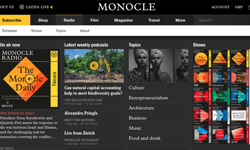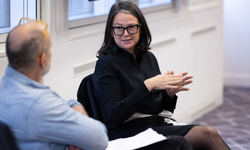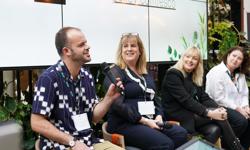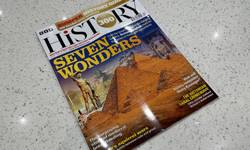For years, children’s editor Cally Poplak was asked when she’d be ready to move on to adult publications. People don’t ask that any more.
Appreciation for the children’s publishing industry has grown along with its fortunes; while many publishers have endured tough times in recent years, the children’s magazine market has grown to £140 million a year in the UK, and the children’s book market is worth £358 million.
Egmont Publishing generates roughly half of its revenue from magazines and half from books, all aimed at children ranging from babies to teens. Many of its best-known brands straddle both categories, and the company’s managing director, Cally Poplak, says the creative teams on each often sit alongside one another, sharing expertise and ideas.
Egmont Publishing claims to be the market leader for children’s publishing in the UK, and sees its mission as inspiring children to read and fostering in them a love of words. Its twenty magazine titles include Toxic, aimed at primary-school-aged boys, We Love Pop, primarily read by early-teen and tweenage girls, and, for pre-schoolers, Frozen and Thomas & Friends. Its book authors and illustrators include Michael Morpurgo, Enid Blyton, Lemony Snicket and Julia Donaldson.
“All we do is children, and we all get a kick out of inspiring children to read. Everybody is focused on that,” Poplak says. “That’s why we’re as proud and excited about a literary prize-winning novel as we are about a licensed magazine that might be your first way into reading. You have to love and respect what children are reading and I think there’s nothing more important than that, giving them that habit of reading, whatever that looks like, whether that’s Toxic or War Horse. It’s whatever grabs them and makes them think ‘reading is for me’, not that reading is something that happens somewhere else or is about school.”
Scandinavian roots
Egmont Publishing is part of the Danish media group Egmont, which was founded in 1878 and now has operations in 30 countries and includes Nordisk Film, TV2 in Norway, cinemas, educational publishers and part ownership of the film company Zentropa.
In the UK, Egmont Publishing sells more than a million magazines and a million books each month. Egmont’s UK presence began in 1991, when the parent company bought Fleetway – publisher or Buster, Roy of the Rovers and 2000AD – from IPC Media. The UK company in its present form, publishing licensed magazines and its own titles, has been growing since 2000. It has roughly doubled in size, adding new titles under licence – these include Lego Star Wars, Angry Birds and Barbie - plus its own titles. We Love Pop launched four years ago and features celebrities such as Justin Bieber and the blogger Zoella, music news and make-up tips. The Disney Frozen magazine launched last year with a debut ABC of just over 91,000. Titles such as Thomas & Friends, Disney & Me and Toxic have been growing at between 4 and 10 per cent a year.
Given the sensitivities – and regulatory restrictions – around advertising to children, the magazines contain very little advertising; almost all revenue comes from newsstand sales.
Paw Patrol is the newest magazine to hit the shelves, released in March 2016. The title is based on the Nickelodeon children’s series and is aimed at pre-school boys and girls. The first issue came with a hat, badge, torch set and giant pull-out poster. Bing, a pre-school title linked to the BBC’s CBeebies brand is launching in July.
Cover-mounted toys
Most of the children’s magazines feature a cover-mounted toy that is as eye-catching as the masthead. Poplak says children choosing a magazine tend to be drawn to the character and title they love, though the toy helps. “Our sense is it’s very much about the brand that they’re into. A child, when they love something, they want it in every shape and form,” she says. “And parents want a product that will bear repeated use, so the toy provides instant gratification and then you get into the content.”
When young children are choosing a magazine, or someone is choosing one to give to them, the options run far beyond other magazines on the shop shelf. This is a sector with a hugely varied competitive set.
“There are a lot of activities available online, and there are other cheap treats, like sweets and small toys,” Poplak concedes. “So what is it about the magazines that still resonates? We believe there’s something in the paper-ness of it that makes it special and different. You can scribble on them, tear them, cut things out and stick them on the walls. You can share a magazine in a way that doesn’t happen with digital. Often, as well, magazines are seen as reading by stealth. They’re fun, and often the kids don’t even notice they’re reading. Print magazines are seen as ‘treats with benefits’ – fun for the child, educationally sound, rewarding to share.”
Digital experimentation
The rise of digital devices has been a catalyst for experimentation at Egmont, as with most other consumer publishers. Poplak said they didn’t fear print being killed off by digital, but saw it as a potential way to widen the net. Tablet ownership per household has now passed the 80% mark, according to Ofcom, and Childwise says two thirds of children have their own tablet.
“Part of our thinking was, if the world of the child is increasingly digital, we want our content to be on their device wherever they are,” she said. When Apple launched the iPad, Winnie-the-Pooh was offered as a free download. Egmont has since developed interactive apps and has worked with EA Games to do an interactive book for the Nintendo DS handheld games console.
“We’ve done all sorts of things and have been very open about working with anyone who wanted to experiment with us in order to try and reach a wider audience or find different ways of telling stories and delivering content.”
Digital content linked to print titles is popular among users of the print products, and helps build a sense of community, but it hasn’t been a game-changer in the children’s market, Poplak says.
“None of them have taken off. Meanwhile, all the data shows the print market (for children) increasing. What we’ve seen is they still love reading in print. Print isn’t old-fashioned; it delivers something that digital doesn’t.”
Parental guidance
“Whilst parents embrace quality digital content, they have a deep anxiety about screen time and a strong desire for reading to happen away from the screen,” she says. Parents tend to use devices as babysitters when they need to get other things done, and children are quite happy tapping at screens alone. The ‘paper-ness’ of reading a physical product – especially so with books but also with magazines - is something that can’t be replicated on a gadget, and is something that parents and children more often share.
Poplak points to a recent Ikea Play Report conducted by Family Kids and Youth, a global study of 29,000 parents and children in twelve countries, which shows that nearly three-quarters of parents think there should be times at home when mobile devices are not used; a quarter think their child is addicted to the internet.
Ethnographic research commissioned by Egmont identified a wholly different experience taking place depending whether reading takes place on a screen or in print. When there’s a screen, both parent and child look down at the device, and are largely directed by it. When the text and images are physical, they look at each other, discuss the content more, do characters’ voices and sounds themselves and are far more engaged with each other.
Print products help parents feel good about bringing up their children well, and children actually prefer it too. Poplak says three quarters of children up to age seventeen prefer reading in print, according to research done for Egmont by Nielsen. “Children haven’t changed. They still love to collect, they want to own something and love it and share it with their friends and have it on their wall. There’s something, still, that’s very special and different about being in print, and something deeply emotional about reading with your child in print.”
What the rise of digital publishing has done, however, is provide a new source of characters and creativity for products in print. Egmont publishes an Angry Birds magazine, its teen titles feature celebrity video bloggers, books linked to YouTube personality Stampy Cat, and the Minecraft online game. Minecraft’s popularity in print surprises even Poplak. “The fan can get a lot of the information online, and of course, as soon as it’s in print, it’s out of date. But there’s something about really cleverly curated content, really beautifully packaged, that makes people want to own it.”
This is a lucrative source of revenue, Poplak says, but also helps publishers get youngsters hooked; they reach for characters and brands they’ve met in other media and seek them out in print. Without realising it, they’re reading for pleasure. “Why does that matter?” she asks.
Importance of reading
“Because the OECD says reading for pleasure is more important than wealth and social class to a child’s academic achievement at school.”
The future, Poplak says, will come from retaining current readers, bringing in new ones, and, crucially, urging people who already buy in print to buy more frequently. A national study of purchasing habits found there are sixteen million adults who buy children’s books and magazines in the UK; of those, about seven million only buy books, two million only buy magazines, and seven million buy both. Children’s magazine buyers on average buy only three or four issues a year. If each bought one more, that would amount to millions more in revenue.
It is yet to become clear how today’s teens and toddlers will regard reading on paper versus a digital screen when they become adults, though Poplak takes heart from the fact that many adults are still buying paper books as well as ebooks, and are collecting other physical media such as vinyl records. For now, she’s happy that the children – and their parents – are happy.
“Our research shows that print books and magazines facilitate quality time between parent and child, which is loved by both – and this is one of the reasons why I am confident of the continuing strength of the children’s print market.”
Managing Director: Cally Poplak
Launched: 1878
Newest launch: Paw Patrol
Best-known brands: Thomas & Friends, We Love Pop, Winnie-the-Pooh, Bob the Builder
Turnover: £53.7m (2015)
Employees: 180












